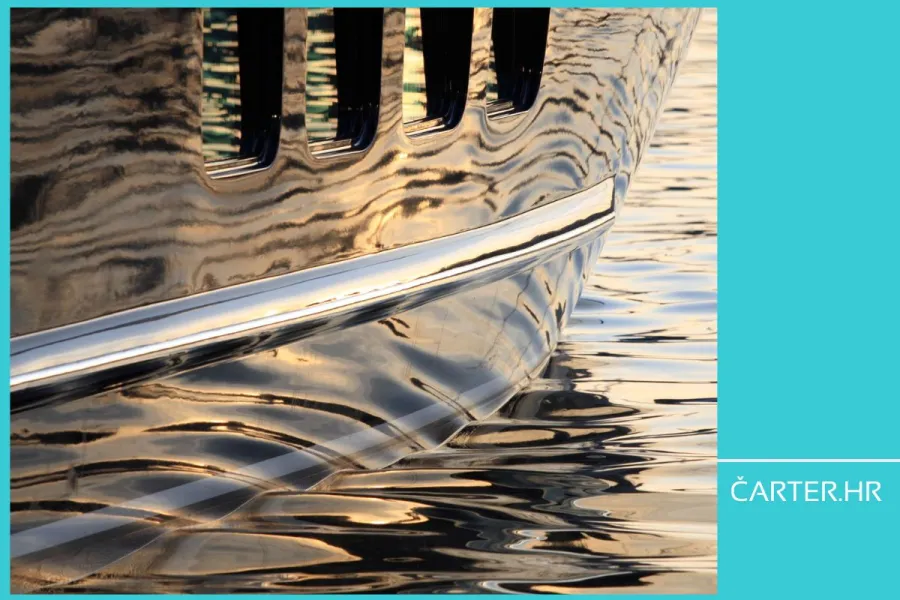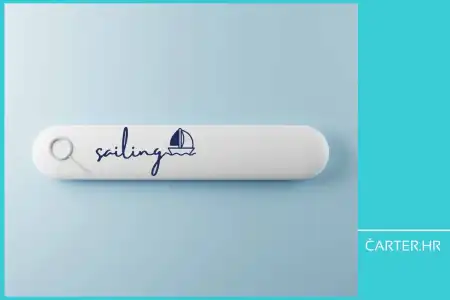
- 14.01.2025.
- News
Safety. Quality. Superior appearance. These are surely the words you want to associate with your charter yachts. Do you know that the very aesthetics of a yacht are often the deciding factor for guests? Often, it is the appearance that tips the scale in the decision... And what better way to attract guests than with a shiny, clean, and high-quality polished yacht?
Yacht polishing is not just a procedure "for looks" but also a necessary step if you want to maintain the functionality of the yacht. A shiny, well-polished hull looks attractive, and more importantly, it is resistant to environmental influences.
Sea salt, UV rays, and constant exposure to weather conditions gradually degrade the gelcoat structure.
The surface becomes porous, loses its shine, and becomes prone to damage. Regular polishing creates a protective layer that repels salt, sunlight, and dirt, preventing more severe damage.
The difference between regular polishing and neglect is clearly visible.
A neglected hull becomes matte, and cracks will begin to appear, while a regularly polished one clearly shows that someone has cared for the yacht.
And one more thing—a yacht that is not polished often looks older than it actually is, which can negatively affect its market value.
Benefits of regular yacht polishing
Regular polishing of a yacht extends its lifespan. Maintaining the surface layer in good condition means fewer damages and less material wear, which prevents the occurrence of further problems such as osmosis.
Reducing maintenance costs is an additional benefit.
By polishing the yacht on time, you prevent the accumulation of dirt and the formation of stubborn deposits that later require more expensive and complicated interventions. In the long run, regular maintenance of the surface means less investment in repairs.
If you are considering buying or selling a yacht, know that regular polishing can significantly increase the market value of the yacht.
Guests also often choose yachts based on what they see in pictures, and a well-maintained yacht will definitely leave a better impression.

How to choose the right tools and products for polishing?
Properly chosen tools and products for polishing are essential for preserving the appearance and durability of the yacht. Polishing is not done just for aesthetics; it is a technical process that requires the right tools and materials to achieve long-lasting effects.
It is important to choose products specifically designed for yachts and the marine environment, as they provide the necessary resistance to salt and UV radiation.
Polishing products—what to choose?
There is a wide range of polishing products on the market, but not all are equally effective or suitable for yachts. The most important products include:
- Polishing pastes—designed for removing oxidation, scratches, and roughness. A paste with fine abrasives is ideal for yachts as it gently removes imperfections without damaging the gelcoat.
- Protective waxes—after polishing, wax creates a protective layer that repels water, salt, and UV rays. It is recommended to use waxes adapted to marine conditions for the best protection.
- Finishing products—sprays or liquids used as a final layer for additional smoothness and shine.
When purchasing, the key is to choose products with formulations designed for the marine environment. Products containing UV inhibitors provide additional protection against colour fading caused by the sun. Also, products that offer a waterproofing effect make the surface more resistant to water stains and dirt.

Polishing tools—Which are the most suitable?
The choice of tools will also affect the results of polishing. Professional tools allow faster and more precise work, while manual tools provide greater control for detailed work.
- Orbital polishers—these tools evenly distribute pressure and reduce the risk of overheating or damaging the surface. They are suitable for larger areas and save time.
- Manual polishing—for small areas or sensitive parts, manual polishing with microfibre cloths and sponges is often the best choice.
- Polishing pads—there are different types of pads, including coarse ones for removing scratches and fine ones for finishing. Microfibre or foam pads are most commonly used for yachts.
In addition to these tools, quality protective equipment, such as gloves and dust masks, is essential.
How to recognise quality products?
Quality polishing products should meet several criteria:
- Long-lasting resistance—products that provide durable protection—save time and effort.
- Adapted to gelcoat—gelcoat is a specific material, so products that act gently but effectively are needed.
- Ease of application—products that are easy to apply and remove enable faster and more even results.
Tips for optimal selection
Before purchasing necessary materials (or even tools), research reviews and recommendations. Brands like 3M, Meguiar’s, or Star Brite are often the first choice for professionals due to their proven quality.
Before use, study the instructions to ensure you use the products correctly.

The process of yacht polishing—step by step
Polishing a yacht is a detailed process that requires planning and precise execution. Each phase plays its role in achieving the desired result—a shiny, smooth, and protected hull surface.
Preparing the surface for polishing
Before starting the polishing process, the hull of the yacht must be thoroughly cleaned. This includes removing all traces of salt, algae, limescale deposits, and other dirt. It is recommended to use high-quality cleaning products specifically designed for marine conditions, such as degreasers and removers for stubborn deposits.
After cleaning, the hull must be dried so that the polishing products can work directly on the surface. A wet surface can reduce the effectiveness of polishing, and remaining dirt can cause scratches. At this stage, it is also important to inspect the hull for any damage, such as cracks or deep scratches, which might require additional treatment before polishing.
Applying polishing products
Polishing begins with the choice of the appropriate polishing paste. For yachts showing signs of oxidation, a paste with mild abrasive properties is recommended. If the surface requires fewer corrections, a fine polish that emphasises shine is used.
The paste is applied in small amounts to avoid creating excess on the surface. Circular motions ensure even application and reduce the risk of visible streaks. When using an orbital polisher, it is crucial to choose the appropriate pad—coarser for removing imperfections and softer for finishing. The polisher should be guided slowly and evenly, avoiding excessive pressure that could damage the gelcoat.
For areas that are difficult to reach, such as edges or joints, manual polishing with a microfibre cloth is recommended, as it provides better control and precision on sensitive parts.
Final shine and protection—applying protective wax
After polishing the hull, the next step is applying protective wax. Wax creates a protective layer that repels water, prevents salt buildup, and protects the surface from UV rays. Wax is applied thinly and evenly, either manually with a sponge or with the help of a polisher.
Once the wax is applied, it should be left to dry for a few minutes, depending on the manufacturer’s instructions. The surface is then polished with a soft cloth or a special pad until a high shine is achieved. The yacht will not only look like new but will also be protected.
Tips for best results
- Work in a shaded area or when the temperature is moderate to prevent the quick evaporation of polishing products and wax.
- Use only clean tools and cloths to avoid scratches.
- Divide the surface into smaller sections and polish them one by one to ensure consistent results.
A properly executed polishing process restores the yacht's appearance, extends its lifespan, and facilitates future maintenance.

How often should a yacht be polished?
For yachts used in charters, polishing should be a regular part of annual maintenance. How often a yacht should be polished depends on the conditions of use, the environment, and the intensity of exposure to weather elements.
Charter yachts undergo more intensive use and are exposed to greater challenges than private yachts, which is why they require more frequent polishing to maintain both their appearance and functionality.
Recommended frequency of polishing for charter yachts:
- Seasonal polishing - before the start of the charter season, detailed polishing of the entire hull is recommended. This ensures an excellent first impression for guests and creates a protective layer against salt, sun, and dirt during intensive use.
At the end of the charter season, additional polishing is recommended to remove accumulated salt, algae, and oxidation and to restore the protective layer. - During the charter season - if the yacht is continuously sailing in demanding conditions (e.g., in areas with high salinity or strong UV radiation), quick waxing is recommended every 2-3 months. This process is not the same as full polishing but helps maintain the protective layer and shine.
Factors influencing the frequency of polishing:
- Exposure to sun and salt—yachts that frequently sail or are moored in areas with strong sun and high salinity (e.g., the Adriatic Sea) lose their protective layer more quickly.
- Type of gelcoat—older gelcoats are prone to faster fading and oxidation, requiring more frequent polishing.
- Intensity of use—charter yachts that are almost constantly in use endure greater mechanical stress and exposure, accelerating surface wear.
Recommendation: Monitor the condition of the surface through regular inspections; if you notice fading, roughness, or signs of oxidation, polishing should be done immediately, regardless of the schedule.
For charter yachts, the optimal frequency of polishing is at least twice a year, with additional refreshing if necessary. This practice preserves the yacht's aesthetics and reduces long-term maintenance costs.
Tips for maintaining shine between polishings:
- Rinsing the hull with plain water after every outing helps retain shine. Salt and dirt should be regularly removed to prevent the formation of stubborn deposits.
- Products for daily maintenance, such as quick polish sprays, can be useful for a quick refresh. However, these products do not replace thorough polishing but extend the time between two processes.
- Protecting the yacht from weather conditions, such as using a cover while the yacht is moored, also helps preserve shine. Reducing exposure to UV radiation and rain will make the protective layer last longer.

Professional polishing or DIY approach
Hiring polishing experts is often the best option if you want quality and long-lasting results. They will use professional equipment and specialised products to ensure precision and quality.
The most common mistakes in DIY polishing include using inappropriate products, overly aggressive sanding, or uneven product application.
These mistakes can cause permanent surface damage, which later results in higher repair costs.
In situations where the hull is severely damaged or requires specific treatment, it is best to leave the job to people with experience and knowledge in handling such issues.
Would you like to learn more useful tips like these and get the latest information on other topics from the nautical and charter industry? Sign up to our newsletter!
We regularly share verified information and practical tips to help your yachts maintain their value and allow you to provide unforgettable experiences for guests or simply enjoy them.
Don’t forget to follow us on our social media channels—Facebook, Instagram, and LinkedIn.
Categories of trends
- News
- Sale
- Marketing
- SEO
- Web design
- Social media
- Technology
- Regulations
- Management
- Education
- Finances
- User experience
Newsletter
Sign up for the newsletter and receive the latest trends and tips straight to your inbox




